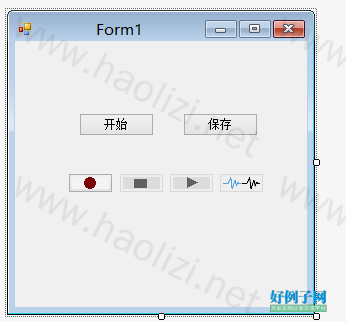实例介绍
【实例简介】需要安装DirectX Runtime Jun 2010
【实例截图】

【核心代码】
using System;
using System.Collections.Generic;
using System.ComponentModel;
using System.Data;
using System.Drawing;
using System.IO;
using System.Linq;
using System.Text;
using System.Threading;
using System.Windows.Forms;
using Microsoft.DirectX.DirectSound;
namespace test2
{
public partial class Form1 : Form
{
public Form1()
{
mWavFormat = SetWaveFormat();
//
// Windows 窗体设计器支持所必需的
//
InitializeComponent();
//
// TODO: 在 InitializeComponent 调用后添加任何构造函数代码
//
}
private WaveFormat SetWaveFormat()
{
WaveFormat format = new WaveFormat();
format.FormatTag = WaveFormatTag.Pcm;//设置音频类型
format.SamplesPerSecond = 22050;//采样率(单位:赫兹)典型值:11025、22050、44100Hz
format.BitsPerSample = 16;//采样位数
format.Channels = 1;//声道
format.BlockAlign = (short)(format.Channels * (format.BitsPerSample / 8));//单位采样点的字节数
format.AverageBytesPerSecond = format.BlockAlign * format.SamplesPerSecond;
return format;
//按照以上采样规格,可知采样1秒钟的字节数为22050*2=55100B 约为 53K
}
//创建WAVE文件
private void CreateWaveFile(string strFileName)
{
fsWav = new FileStream(strFileName, FileMode.Create);
mWriter = new BinaryWriter(fsWav);
/**************************************************************************
Here is where the file will be created. A
wave file is a RIFF file, which has chunks
of data that describe what the file contains.
A wave RIFF file is put together like this:
The 12 byte RIFF chunk is constructed like this:
Bytes 0 - 3 : 'R' 'I' 'F' 'F'
Bytes 4 - 7 : Length of file, minus the first 8 bytes of the RIFF description.
(4 bytes for "WAVE" 24 bytes for format chunk length
8 bytes for data chunk description actual sample data size.)
Bytes 8 - 11: 'W' 'A' 'V' 'E'
The 24 byte FORMAT chunk is constructed like this:
Bytes 0 - 3 : 'f' 'm' 't' ' '
Bytes 4 - 7 : The format chunk length. This is always 16.
Bytes 8 - 9 : File padding. Always 1.
Bytes 10- 11: Number of channels. Either 1 for mono, or 2 for stereo.
Bytes 12- 15: Sample rate.
Bytes 16- 19: Number of bytes per second.
Bytes 20- 21: Bytes per sample. 1 for 8 bit mono, 2 for 8 bit stereo or
16 bit mono, 4 for 16 bit stereo.
Bytes 22- 23: Number of bits per sample.
The DATA chunk is constructed like this:
Bytes 0 - 3 : 'd' 'a' 't' 'a'
Bytes 4 - 7 : Length of data, in bytes.
Bytes 8 -: Actual sample data.
***************************************************************************/
char[] ChunkRiff = { 'R', 'I', 'F', 'F' };
char[] ChunkType = { 'W', 'A', 'V', 'E' };
char[] ChunkFmt = { 'f', 'm', 't', ' ' };
char[] ChunkData = { 'd', 'a', 't', 'a' };
short shPad = 1; // File padding
int nFormatChunkLength = 0x10; // Format chunk length.
int nLength = 0; // File length, minus first 8 bytes of RIFF description. This will be filled in later.
short shBytesPerSample = 0; // Bytes per sample.
// 一个样本点的字节数目
if (8 == mWavFormat.BitsPerSample && 1 == mWavFormat.Channels)
shBytesPerSample = 1;
else if ((8 == mWavFormat.BitsPerSample && 2 == mWavFormat.Channels) || (16 == mWavFormat.BitsPerSample && 1 == mWavFormat.Channels))
shBytesPerSample = 2;
else if (16 == mWavFormat.BitsPerSample && 2 == mWavFormat.Channels)
shBytesPerSample = 4;
// RIFF 块
mWriter.Write(ChunkRiff);
mWriter.Write(nLength);
mWriter.Write(ChunkType);
// WAVE块
mWriter.Write(ChunkFmt);
mWriter.Write(nFormatChunkLength);
mWriter.Write(shPad);
mWriter.Write(mWavFormat.Channels);
mWriter.Write(mWavFormat.SamplesPerSecond);
mWriter.Write(mWavFormat.AverageBytesPerSecond);
mWriter.Write(shBytesPerSample);
mWriter.Write(mWavFormat.BitsPerSample);
// 数据块
mWriter.Write(ChunkData);
mWriter.Write((int)0); // The sample length will be written in later.
}
private bool CreateCaputerDevice()
{
//首先要玫举可用的捕捉设备
CaptureDevicesCollection capturedev = new CaptureDevicesCollection();
Guid devguid;
if (capturedev.Count > 0)
{
devguid = capturedev[capturedev.Count - 1].DriverGuid;
}
else
{
MessageBox.Show("当前没有可用于音频捕捉的设备", "系统提示");
return false;
}
//利用设备GUID来建立一个捕捉设备对象
capture = new Capture(devguid);
return true;
}
private void CreateCaptureBuffer()
{//想要创建一个捕捉缓冲区必须要两个参数:缓冲区信息(描述这个缓冲区中的格式等),缓冲设备。
CaptureBufferDescription bufferdescription = new CaptureBufferDescription();
bufferdescription.Format = mWavFormat;//设置缓冲区要捕捉的数据格式
iNotifySize = mWavFormat.AverageBytesPerSecond / iNotifyNum;//设置通知大小
iBufferSize = iNotifyNum * iNotifySize;
bufferdescription.BufferBytes = iBufferSize;
capturebuffer = new CaptureBuffer(bufferdescription, capture);//建立设备缓冲区对象
}
//设置通知
private void CreateNotification()
{
BufferPositionNotify[] bpn = new BufferPositionNotify[iNotifyNum];//设置缓冲区通知个数
//设置通知事件
notifyevent = new AutoResetEvent(false);
notifythread = new Thread(new ThreadStart(RecoData));
notifythread.Start();
for (int i = 0; i < iNotifyNum; i )
{
bpn[i].Offset = iNotifySize i * iNotifySize - 1;//设置具体每个的位置
bpn[i].EventNotifyHandle = notifyevent.Handle;
}
myNotify = new Notify(capturebuffer);
myNotify.SetNotificationPositions(bpn);
}
//线程中的事件
private void RecoData()
{
while (true)
{
// 等待缓冲区的通知消息
notifyevent.WaitOne(Timeout.Infinite, true);
// 录制数据
RecordCapturedData();
}
}
//真正转移数据的事件,其实就是把数据转移到WAV文件中。
private void RecordCapturedData()
{
byte[] capturedata = null;
int readpos = 0, capturepos = 0, locksize = 0;
capturebuffer.GetCurrentPosition(out capturepos, out readpos);
locksize = readpos - iBufferOffset;//这个大小就是我们可以安全读取的大小
if (locksize == 0)
{
return;
}
if (locksize < 0)
{//因为我们是循环的使用缓冲区,所以有一种情况下为负:当文以载读指针回到第一个通知点,而Ibuffeoffset还在最后一个通知处
locksize = iBufferSize;
}
capturedata = (byte[])capturebuffer.Read(iBufferOffset, typeof(byte), LockFlag.FromWriteCursor, locksize);
mWriter.Write(capturedata, 0, capturedata.Length);//写入到文件
iSampleSize = capturedata.Length;
iBufferOffset = capturedata.Length;
iBufferOffset %= iBufferSize;//取模是因为缓冲区是循环的。
}
private void button1_Click_1(object sender, System.EventArgs e)
{
Thread.Sleep(100);
capturebuffer.Stop();
capturebuffer = null;
fsWav.Close();
MessageBox.Show("保存成功");
}
private void button2_Click(object sender, System.EventArgs e)
{
CreateWaveFile("d:/test.wav");
if (!CreateCaputerDevice())
return;
CreateCaptureBuffer();//创建缓冲
CreateNotification();//设置通知
capturebuffer.Start(true);
}
}
}
好例子网口号:伸出你的我的手 — 分享!
网友评论
小贴士
感谢您为本站写下的评论,您的评论对其它用户来说具有重要的参考价值,所以请认真填写。
- 类似“顶”、“沙发”之类没有营养的文字,对勤劳贡献的楼主来说是令人沮丧的反馈信息。
- 相信您也不想看到一排文字/表情墙,所以请不要反馈意义不大的重复字符,也请尽量不要纯表情的回复。
- 提问之前请再仔细看一遍楼主的说明,或许是您遗漏了。
- 请勿到处挖坑绊人、招贴广告。既占空间让人厌烦,又没人会搭理,于人于己都无利。
关于好例子网
本站旨在为广大IT学习爱好者提供一个非营利性互相学习交流分享平台。本站所有资源都可以被免费获取学习研究。本站资源来自网友分享,对搜索内容的合法性不具有预见性、识别性、控制性,仅供学习研究,请务必在下载后24小时内给予删除,不得用于其他任何用途,否则后果自负。基于互联网的特殊性,平台无法对用户传输的作品、信息、内容的权属或合法性、安全性、合规性、真实性、科学性、完整权、有效性等进行实质审查;无论平台是否已进行审查,用户均应自行承担因其传输的作品、信息、内容而可能或已经产生的侵权或权属纠纷等法律责任。本站所有资源不代表本站的观点或立场,基于网友分享,根据中国法律《信息网络传播权保护条例》第二十二与二十三条之规定,若资源存在侵权或相关问题请联系本站客服人员,点此联系我们。关于更多版权及免责申明参见 版权及免责申明



支持(0) 盖楼(回复)
支持(0) 盖楼(回复)